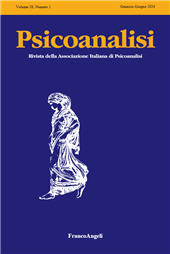Il crepuscolo della coscienza : tra veglia e sonno
5-14 p.
La psicoanalisi fonda la sua teoria e la sua prassi clinica sull'interpretazione dei so-gni. Dall'opera monumentale della Traumdeutung freudiana, che dichiara l'indagine dei processi onirici la "via regia per l'inconscio", fino alle affascinanti speculazioni di Wil-fred Bion, che ribalta l'assunto senza scardinarlo, dicendo che non è l'inconscio che crea il sogno, ma il sogno che crea l'inconscio, possiamo confermare l'importanza basilare del sognare in salute e in malattia. Una rispettabile, ma minor mole di studi è dedicata in ambito psicoanalitico al sonno, premessa fisiologica del sognare, fenomeno comune agli umani e ad altri animali, che dall'ambito originario del mito è divenuto oggi sempre più oggetto dell'indagine privilegiata della neurofisiologia e delle neuroscienze. Questo lavoro si dedica invece a un terzo tema meno noto e celebrato: quello dei processi psichici che precedono l'addormentamento; e, simmetricamente, al percorso inverso del risveglio.
Il trascorrere dalla veglia al sonno e viceversa, esperienza al tempo stesso banale e perturbante, è uno spazio di coscienza sospesa nel quale abbiamo la possibilità di sorprendere noi stessi; una zona privatissima, ipersoggettiva, nella quale talora gli artisti e gli scienziati hanno un contatto privilegiato con il preconscio e con la creatività. [Testo dell'editore].
Psychoanalysis bases its theory and clinical practice on the interpretation of dreams. From the monumental work of the Freudian Traumdeutung, which declares the investiga-tion of dream processes the "royal road to the unconscious", up to the fascinating speculations of Wilfred Bion, who overturns the assumption without undermining it, saying that it is not the unconscious that creates the dream, but the dream creates the uncon-scious, we can confirm the basic importance of dreaming in health and in illness. A respectable, but smaller amount of studies in the psychoanalytic field is dedicated to sleep, the physiological premise of dreaming, a phenomenon common to humans and other animals, which from the original context of myth has today increasingly become the object of the privileged investigation of neurophysiology and of neuroscience.
This work instead dedicates itself to a third, less well-known and celebrated theme: that of the psychic processes that precede falling asleep; and, symmetrically, to the reverse path of awakening. The passage from wakefulness to sleep and vice versa, an experience that is both banal and disturbing, is a space of suspended consciousness in which we have the possibility of surprising ourselves; a very private, hypersubjective zone in which artists and scientists sometimes have privileged contact with the preconscious and with creativity. [Publisher's Text].
-
Articoli dello stesso fascicolo (disponibili singolarmente)
-
-
Informazioni
Codice DOI: 10.3280/PSI2024-001001
ISSN: 1972-490X
MATERIE
PAROLE CHIAVE
- veglia, sonno, percezioni endopsichiche, fantasie scientifiche, creatività, dimensione crepuscolare del pensiero
- waking, sleep, endopsychic perceptions, scientific fantasies, creativity, twilight dimension of thought


